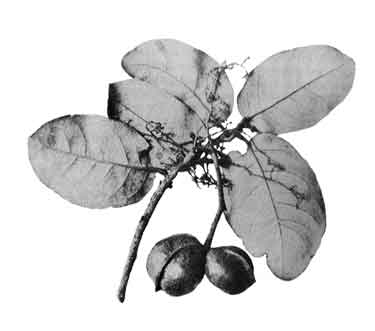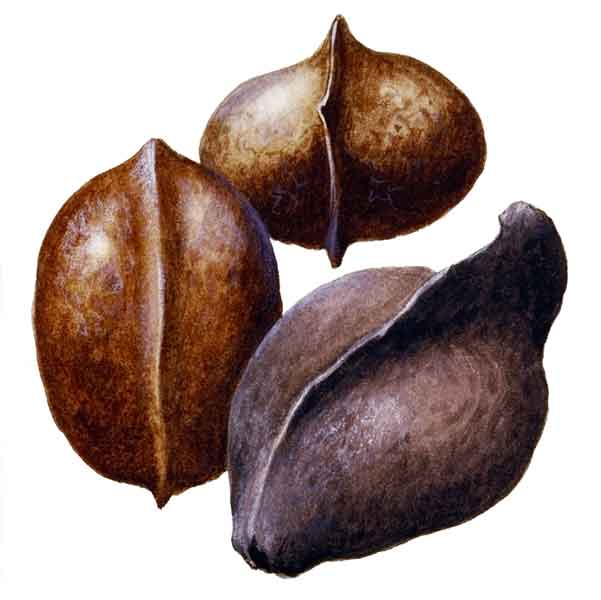
Botany
Dungon-late is an evergreen mangrove tree , growing up to 25 meters high. Bark is grayish, fissured, and scaly. Leaves are oblong-ovate to elliptic-ovate, 10 to 20 centimeters long, the apex pointed or blunt, the base usually rounded, the upper surface green, smooth and shining, the lower surface densely covered with small, round, pale or silvery-white scales. Flowers are numerous, yellowish-greenish, bell-shaped, about 5 millimeters long, usually 5-toothed, borne on hairy panicles 7 to 15 centimeters long. Fruit is hard and shining, woody, smooth, broadly boat-shaped, 4 to 8 centimeters long and keeled. Each fruit contains one seed, about 3 centimeters long.
 Distribution Distribution
- Along the seashore throughout the Philippines.
- Also occurs in India to tropical Africa and through Malaya to Polynesia.
Constituents
- Kernel contains 8.32% fat, nitrogenous substances 11.07%, MgO 6.29%, CaO 1.43%, P2O2 22.23%, SO3 8.04%, Cl 1.07%, Al2O3 2.68%, Mn 0.04%, Fe 0.41%.
- Seed contains tannin, fixed oil 7.38% with no caffeine.
- Studies have yielded triterpenes, sesquiterpenes, flavonoids, and a phenylpropanoid-glycerol.
- Ethanol extract of leaves yielded eight
flavonoids: quercetin, kaempferol-3-O-(6"-O-E-p-coumaroyl)-ß-D-glucopyranoside, kaempferol, kaempferitrin, myricetin, eriodictyol, and catechin. (4)
- An ethanolic leaf extract yielded a new cinnamolyglycoflavonoid 3-cinnamoyltribuloside (1), its precursor tribuloside and two known flavonoid glycosides afzelin and astilbin. A dichlormethane leaf extract yielded two known pentacyclic triterpenoids, 3ß-tarxerol and friedelin. (see study below) (9)
- Alcohol extract of leaves yielded 8 compounds viz.,
protocatechuic acid (1), 3,5,7-trihydroxychromone-3-O-a-L -rhamnopyranoside (2), epicatechin (3), kaempferol-3-O-β-D-glucopyranoside (4), quercetin-3-O-α-L-rhamnopyranoside (5), (2R,3R)-dihydroquercetin-3-O-α-L-rh-amnopyranoside (6), kaempferol-3-O-α-L-rhamnopyranoside (7), kaempferol-3-O-(6"-O-E-p-coumaroyl)-β-D-glucopyranoside (8). (13)
Properties
- Fruits can float for weeks and will germinate when stranded at high tide.
-
Studies have shown anti-inflammatory, antioxidant properties.
Parts used
Seeds, roots.
 Uses Uses
Edibility
- Seeds and leaves of plant taken as edible in the Nicobar and Andaman islands. (8)
Folkloric
- In the Moluccas, extract of seeds used for diarrhea and dysentery.
- In Vietnam, decoction of seeds used for diarrhea and dysentery.
- In China, used for hematuria and dysentery. Roots used for traumatic injuries.
- In the Bondo district of Kenya, a root decoction is drunk to treat mouth infection, intestinal worms, stomach ache and toothaches. (10)
- In India, used for diarrhea and as antifungal.
- In India, the indigenous tribe of Andaman and Nicobar Islands apply the plant topically to treat fever. (18)
Others
• Timber tree: Known in the Philippines as a timber tree – used for piling, posts, foundation, ties, paving blocks, ship building, joists, rafters, hubs, spokes, handles for picks, axes and other tools. (•) In Malaysia, once considered one of its toughest timbers. It was valued for stopping bullets, and stockades were build of it and raised the thwarts of their pirate canoes with it. (Burkill) (14)
• Paper: Used in making paper pulp.
• Firewood: An excellent source of firewood.
• Bark tannin: Used for toughening fishnets.
• Toothbrush: In Malaya, twigs used as toothbrush.
• Repellent: Stems and leaves used as mosquito repellent; also as piscicide,
• Fish poison: Sap used as fish, arrowhead, and spearhead poison. Roots used as fish poison. (14) (15)
Studies
• Anti-Inflammatory / Ergosterol Peroxide / Bark: Study evaluated various bark extracts for nitric oxide (NO) inhibitory effects using RAW264.7 macrophage cells. Ergosterol peroxide exhibited the highest activity against NO release. The mechanism in transcriptional level of ergosterol peroxide was dose-dependent down regulation of mRNA expressions of iNOS and COX-2. (1)
• Antioxidant / DPPH Radical Scavenging Activity: In a study of ethanol extracts of 53 parts of 36 species of plants for antioxidant-related activities, H littoralis (branches) was one of six plants that showed strong DPPH radical scavenging activity. (2)
• Antimycobacterial / DPPH Radical Scavenging Activity: Extracts and compounds isolated from ethanolic and dichlormethane leaf extracts, with the exception of 3ß-taraxerol, exhibited antimycobacterial activity against non-pathogenic Mycobacterium species M. madagascariense and M. indicus pranii. The extracts together with 3-cinnamoyltribuloside (1), tribuloside, and astilbin exhibited DPPH radical scavenging activity. (see constituents above) (9)
• Antiamoebic / Entamoeba histolytica: Study investigated the antiamoebic activity of Heritiera littoralis extracts. Aqueous ethanol and aqueous extracts showed promising in vitro and in vivo antiamoebic activity. The active extracts possessed 90% activity at 250 mg/kg dose for 7 days. (11)
• Comparative Antioxidant Activity of Various Parts: Study evaluated the antioxidant activities of different parts (leaves, branches, and seeds) of Heriteria littoralis extracts. Results showed different parts had scavenging effect on DPPH and OH free radicals. The scavenging effect was positively related to concentration in a certain concentration range. Average content of total flavonoids in the extracts was between 3.65% and 5.56% (branch extracts) and average phenol content was between 18.83% and 23.27% (branch extracts). (12)
• Potential for Staining Fungal Cultures / Flowers: Study evaluated an ethanolic extract of Heritiera littoralis flowers as staining agent for moulds. Results showed the agent not only stained the hyphae and conidiophores in light pink and coral pink colors respectively, but also delineated all fungal body elements with prominent borders. (16)
• Antioxidant / Total Phenolic Content / Leaves: Study evaluated the antioxidant activity and total phenolic content of leaves of H littoralis. A methanolic extract showed moderate DPPH free radical scavenging activity with IC50 of 27.88 µg/ml compared to positive control ascorbic acid with IC50 7.27 µg/ml. Total phenolic content was 68.21 mg/g GAE of dried extract. (17)
Availability
- Wild-crafted.
|

![]()




 Distribution
Distribution  Uses
Uses 